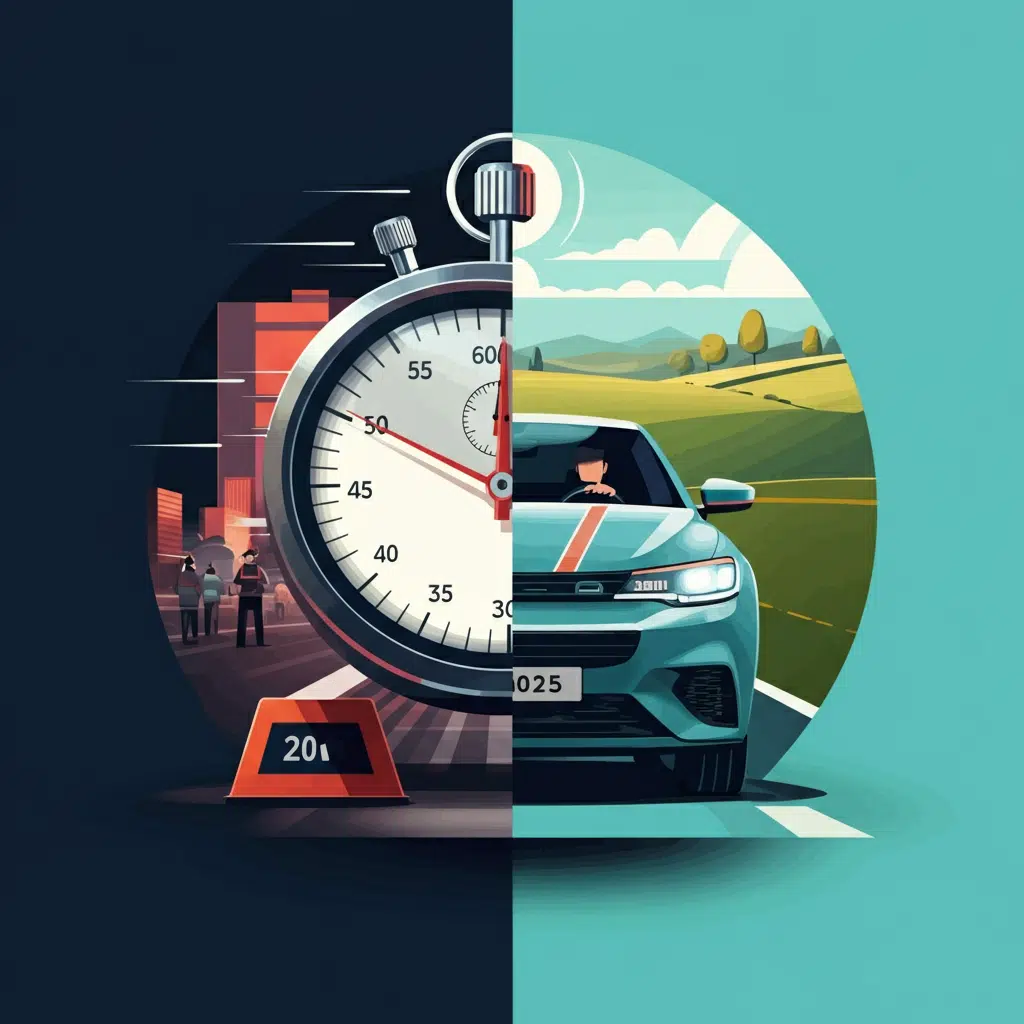Learning to drive in Britain has never been cheap or quick, and 2025 has piled extra delay on top of the usual cost. Standard weekly lessons still hover around £35 to £40 an hour, yet the bigger headache is time: many test-centre queues now stretch for months. By the time you finally reach the examiner’s seat you may have forgotten half the manoeuvres you practised—and paid handsomely to keep them fresh. Against that backdrop, an intensive driving course sounds like magic: one payment, one or two weeks of wall-to-wall tuition, and a fast track driving test booking already lined up for the final afternoon. But is it a genuine shortcut or just slick marketing? Let’s unpack the promise, the pitfalls, and the price tag.
What Exactly Is an Intensive Course?
An intensive (or “crash”) course squeezes the learning you would normally spread over three to six months into a tight block of consecutive days. A typical package bundles twenty, thirty, or forty hours of one-to-one instruction. Some providers add airport-style extras—hotel accommodation near a quiet test centre, daily pick-up, mock tests, theory-test booking if you still need it, even meal plans. From your first lesson until the examiner hands back the score sheet, you may barely step away from the car.
The timetable is relentless: four to six hours behind the wheel each day, brief breaks for coffee and feedback, then straight back to roundabouts and manoeuvres. Because you practise the same techniques again the very next morning, skills lodge quickly in muscle memory; there’s little time to forget the clutch’s biting point or the steering lock for a tight bay park.
Why Demand Has Exploded in 2025
One reason is obvious: sheer waiting lists. Across much of the UK, learners report practical-test slots five months away or more. Add the Driver and Vehicle Standards Agency’s new rule that you must give ten working days’ notice before moving a booking, and short-notice cancellations have become harder to grab. Intensive schools counter that frustration by bulk-buying exam appointments, then matching students to the dates they already hold. If you can pay, you effectively step ahead of learners who refresh the DVSA website at dawn only to see zero availability.
There is also a lifestyle shift in play. Car-insurance discounts for young drivers lean heavily on telematics; the sooner you pass, the sooner you can build a no-claims history. Employers in logistics, care, and on-call trades increasingly prefer applicants with a full licence from day one. A fortnight’s leave to nail the exam can look like an attractive trade-off when the alternative is half a year of weekly lessons, bus fares, and juggling lifts.
Counting the Cost
Prices vary wildly, and the headline figure rarely tells the whole story. A local one-car operation might offer a 25-hour package for £700. National brands with glossy websites pitch 40-hour “gold” courses for £1 800 or more. At first glance the upper end looks eye-watering, but compare it with the drip-feed route:
-
Weekly lessons – 45 hours at £38 totals £1 710 before you add fuel for private practice or the fee for a DVSA booking.
-
Test delays – While you wait those months, you may need refresher lessons—another £300 or so—to keep skills sharp.
-
Hidden lifestyle costs – Commuting by train, turning down shift work that needs a licence, asking friends for lifts—none appear on a driving-school invoice, yet all nibble at your bank balance.
Intensive courses bundle everything into one upfront fee: tuition, car hire, insurance, fuel, and the test itself. If you pass first time, you walk away knowing every penny that left your account. The catch? Fail on Friday afternoon and it can feel as though your wallet went through the shredder. Good providers offer a discounted retest and a couple of extra hours’ tuition, but the original bargain no longer looks quite so shiny.
The Speed Factor—Blessing or Overload?
Immersion is the headline benefit. Drive every day and confidence snowballs: roundabouts stop feeling like spinning saucers; bay parks become instinct; clutch control happens without thought. Many learners discover they enjoy driving only when they swap the stop-start of weekly lessons for a daily rhythm.
Yet speed cuts both ways. Five hours of traffic lights, mirrors, and commentary-driving can fry the keenest brain. Fatigue sneaks up: concentration wobbles, silly mistakes multiply, and by late afternoon your instructor’s feedback starts to blur. If you’re a reflective learner who needs a night to digest new information, the conveyor-belt approach can feel brutal. Some schools now offer semi-intensive schedules—three hours a day over two weeks—to balance momentum with breathing space.
Pass Rates and Pressure
Hard data on intensive-course success are thin. The DVSA publishes national statistics but does not split them by lesson style, so any “95 percent first-time pass!” banner you spot is self-reported marketing. Anecdotally, experienced learners—people who’ve already clocked a dozen private hours—thrive in the immersive environment, while total beginners sometimes buckle under the ticking clock. Confidence matters: if you still stall on gentle hills, cramming may swap steady progress for performance anxiety.
Tech to the Rescue
Two years ago “refresh the DVSA page and hope” felt like the only strategy. In 2025, though, a smart driving test app does the legwork for you. The best apps scan for cancellations in real time, sync with a provider’s diary, and manage your fast track driving test booking without constant screen-tapping. They even bundle theory-revision quizzes, hazard-perception clips, and postcode-based wait-time maps so you can target the most realistic centres. Pairing an intensive course with a reliable driving test app ensures you don’t just get ready—you actually sit the exam while the lessons are still fresh.
Picking a Provider Without the Pain
Because the industry is booming, standards vary. Before you hand over a deposit, tick these boxes:
-
Instructor credentials – Ask for the Approved Driving Instructor (ADI) number and double-check it online.
-
Transparent small print – Read what happens if the test is cancelled by the examiner, you fall ill, or you’re judged “not test-ready” by day four. A fair contract spells out retest costs clearly.
-
Real reviews – Scan independent forums or social-media groups for feedback that sounds like it was written by actual humans, not bots.
-
Test sourcing – Good schools already own the exam slot you need; vague promises of “finding” a date usually mean stress later.
-
Location logic – Training in a quiet market town two hundred miles away is fine, but remember you’ll face your home city’s traffic the moment you drive solo.
Who Gets the Best Value?
-
Fast refreshers – You failed once, need to retake quickly, and your fundamentals are solid.
-
Job starters – The new role begins next month and the contract requires a licence in hand.
-
Students on break – Two empty weeks in summer before heading back to university make perfect course windows.
On the flip side, first-timers who still sweat over basic clutch control often fare better with weekly lessons that allow confidence to bloom slowly. Nervous drivers sometimes need reflection time to process feedback and avoid overload.
Final Verdict: A Licence to Spend or a Smart Investment?
Intensive driving courses are neither miracle shortcuts nor money pits; they’re simply tools. Used in the right circumstances, they can be outstanding value—compressing months of effort into a fortnight, shrinking hidden lifestyle costs, and fast-tracking you to the freedom a licence brings. Mis-match the tool to the learner, and it can magnify stress, empty your bank account, and still leave you clutching a fail sheet.
Run the numbers honestly. Add up what you already spend on public transport, lost job options, and drip-fed tuition. Weigh that against the upfront course fee, the possibility of needing extra hours, and, most of all, your own learning temperament. If the maths and the mindset align, an intensive course paired with a reliable driving test app could be the smartest ticket you’ll buy in 2025. If they don’t, take the slower road with confidence—because the destination is the same: a full licence, a set of keys, and the whole country unfolding beyond the windscreen.








